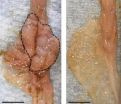(Press-News.org) Researchers at NYU Langone Medical Center have found that blocking the action of a key signaling molecule in the immune system known as Netrin-1 stalls chronic inflammation and insulin resistance tied to obesity and often derived from fatty diets.
Reporting in this week's issue of Nature Medicine, the NYU Langone team showed in experiments in mice and human tissue that Netrin-1 signaling is propelled by fat tissue growth. The team previously discovered that Netrin-1 was secreted by the immune system clean-up cells, or macrophages, whose buildup leads to inflammation.
Among the study's key findings was that inflammatory macrophage buildup is controlled by Netrin-1, which not only attracts more macrophages into fat tissue, but also prevents macrophages from carrying away pathogens and unwanted fat cells as the immune cells would normally do. Uncontrolled inflammation is known to damage arteries and vital organs.
"Our study results show that targeting Netrin-1 can lessen and possibly reverse the chronic inflammation and insulin resistance associated with major diseases tied to obesity, such as atherosclerosis and type II diabetes," says senior study investigator Kathryn Moore, PhD, a professor of medicine and cell biology at NYU Langone Medical Center. "Our goal, of course, is to let inflammation do the infection-fighting tasks it is supposed to do while stopping it from producing any disease-causing effects in fatty tissue that it is not supposed to do."
Lead study investigator Bhama Ramkhelawon, PhD, a postdoctoral fellow in Dr. Moore's lab, says the team's latest findings are believed to be the first to identify a chemical signal that stalls macrophage movement out of fat tissue and causes the chronic inflammation driven by obesity and fatty diets.
According to Dr. Ramkhelawon, Netrin-1 stops macrophages in their tracks, holding them back from continuing their journey to interact with other immune cells and from performing their job in clearing away damaging molecules that accumulate in diseased tissue.
Moore says the team's experiments followed directly from their 2012 research findings published in Nature Immunology, which showed that Netrin-1, a chemical typically associated with nerve development, was abundant and overactive in macrophage cells in atherosclerotic plaques. The team's earlier research had also shown that Netrin-1 bound to macrophages at a protein receptor site called Unc5b, whose action was similarly found to be elevated in fat tissue.
In the latest study, Moore and her team set out to clarify how this happens in obesity and to define the role of Netrin-1 signaling as macrophage buildup, inflammation and insulin resistance occur.
Researchers found that feeding mice a high-fat diet for 20 weeks upped production by as much as 50 percent of both Netrin-1and Unc5b when compared to levels of both in mice fed a lean diet. Results matched Netrin-1 and Unc5b analyses in macrophage samples from fat tissue samples in a dozen people, half of whom were obese.
Further experiments in which palmitate, a fatty acid tied to obesity and thought to promote inflammation, was added to mouse macrophage cultures showed a threefold increase in Netrin-1 and a fivefold increase in Unc5b activity.
Macrophage samples from the fat tissue of obese mice showed reduced movement out of fat tissue. When researchers blocked Unc5b receptors, preventing Netrin-1 attachment, macrophage migration activity was restored.
Additional experiments in mice bred with and without Netrin-1-producing macrophages showed lower inflammation and macrophage movement only in obese mice without Netrin-1. This, in turn, was tied to improvements in a half-dozen metabolic markers of insulin resistance, which builds during obesity, with Netrin-1-deficient mice showing at least 50 percent better blood-sugar control than mice with Netrin-1-producing macrophages.
Researchers next plan to develop highly specific, Netrin-1-inhibiting drugs, which can be targeted to specific macrophage cells or fat tissues as nanotherapies or delivered via catheters, so Netrin-1 function in non-fat tissue elsewhere in the body is allowed to continue normally. They also plan studies to determine when inflammatory damage is likely permanent and non-reversible.
INFORMATION:
Funding support for this study was provided by the National Institutes of Health (NIH), the American Heart Association (AHA), and the Canadian Institutes of Health Research (CIHR). Corresponding grant numbers are RC1HL100815 and T32HL098129 for the NIH, 13POST14490016 for the AHA, and MOP-2390941 for the CIHR.
In addition to Moore and Ramkhelawon, other NYU Langone researchers involved in these studies were Elizabeth Hennessy, PhD; Michael Ménager, PhD; Tathagat Dutta Ray, PhD; Frederick Sheedy, PhD; Susan Hutchison, BSc; Amarylis Wanschel, PhD; Scott Oldebeken, BA; Westley Spiro, BA; and George Miller, MD. Additional research support was provided by Michèle Geoffrion, BSc; Ruth McPherson, MD, PhD; and Katey Rayner, PhD, at the University of Ottawa Heart Institute.
For more information, go to:
http://www.med.nyu.edu/biosketch/moorek09
http://www.nature.com/nm/journal/vaop/ncurrent/index.html
About NYU Langone Medical Center
NYU Langone Medical Center, a world-class, patient-centered, integrated academic medical center, is one of the nation's premier centers for excellence in clinical care, biomedical research, and medical education. Located in the heart of Manhattan, NYU Langone is composed of four hospitals—Tisch Hospital, its flagship acute care facility; Rusk Rehabilitation; the Hospital for Joint Diseases, the Medical Center's dedicated inpatient orthopaedic hospital; and Hassenfeld Children's Hospital, a comprehensive pediatric hospital supporting a full array of children's health services across the Medical Center—plus the NYU School of Medicine, which since 1841 has trained thousands of physicians and scientists who have helped to shape the course of medical history. The Medical Center's tri-fold mission to serve, teach, and discover is achieved 365 days a year through the seamless integration of a culture devoted to excellence in patient care, education, and research. For more information, go to http://www.NYULMC.org, and interact with us on Facebook, Twitter, and YouTube.
Media Inquiries:
David March
212.404.3528│david.march@nyumc.org
Blocking immune signaling stalls inflammation and insulin resistance tied to obesity
Discovery by NYU Langone Medical Center researchers could lead to further advances against diseases tied to obesity and type II diabetes
2014-03-04
ELSE PRESS RELEASES FROM THIS DATE:
High consumption of fish oil may benefit cardiovascular health, Pitt public health finds
2014-03-04
PITTSBURGH, March 4, 2014 – Eating fish in amounts comparable to those of people living in Japan seems to impart a protective factor that wards off heart disease, according to an international study funded by the National Institutes of Health (NIH) and led by the University of Pittsburgh Graduate School of Public Health.
Middle-aged Japanese men living in Japan had lower incidence of coronary artery calcification, a predictor of heart disease, than middle-aged white men living in the United States, likely due to the significantly higher consumption of omega-3 fatty acids ...
Long-term study confirms success of method for detecting spread of deadly skin cancer
2014-03-04
Research at UCLA on a technique for detecting the earliest spread of melanoma, the deadliest form of skin cancer, has confirmed that the procedure significantly prolongs patients' survival rates compared with traditional "watch and wait" techniques.
The technique, which combines lymphatic mapping and sentinel-node biopsy, allows doctors to quickly determine whether the disease has spread, or metastasized, to the lymph nodes, which occurs in approximately 20 percent of patients. Patients with cancer in their lymph nodes may benefit from having their other nearby lymph ...
Light zaps viruses: How photosensitization can stop viruses from infecting cells
2014-03-04
A UCLA-led team of researchers has found evidence that photosensitizing a virus's membrane covering can inhibit its ability to enter cells and potentially lead to the development of stronger, cheaper medications to fight a host of tough viruses.
The UCLA AIDS Institute study, published in the February issue of the Journal of Virology, is part of ongoing research on a compound called LJ001, a "broad-spectrum" antiviral that can attack a wide range of microbes.
The current paper advances the science by showing that the process of photosensitization — heightening a ...
A highly sensitive small molecule probe to evaluate potential risk for Parkinson's disease
2014-03-04
A team of researchers from National University of Singapore (NUS) have created the first two-photon, small molecule fluorogenic probe that can serve as a useful tool for the rapid assessment of an individual's potential risk for Parkinson's disease. The highly sensitive fluorescence probe can detect with high precision the activity of Monoamine Oxidase B (MAO-B), an enzyme that is found in elevated levels in patients with Parkinson's disease. This innovation paves the way for the development of less costly non-invasive technologies and devices to help monitor the risk and ...
Immune system-based therapy produces lasting remissions in melanoma patients
2014-03-04
BOSTON – A drug that unleashes the immune system to attack cancer can produce lasting remissions and hold the disease in check – for more than two years, in some cases – in many patients with advanced melanoma, according to a new study by researchers at Dana-Farber Cancer Institute, Johns Hopkins University, Yale University, and allied institutions.
The study, published online today, March 3, by the Journal of Clinical Oncology, provides the longest-term look so far at how melanoma patients have fared since receiving the drug, nivolumab, in a phase I clinical trial. The ...
Every step you take
2014-03-04
Artificial photosynthesis, in which we emulate the process used by nature to capture energy from the sun and convert it into electrochemical energy, is expected to be a major asset in any sustainable energy portfolio for the future. Artificial photosynthesis offers the promise of producing liquid fuels that are renewable and can be used without exacerbating global climate change. A key to realizing commercial-scale artificial photosynthesis technology is the development of electrocatalysts that can efficiently and economically carry out water oxidation reaction that is ...
Eliminating bacteria, changing lifestyle could lower risk in people genetically susceptible to color
2014-03-04
New York, NY— Bacteria in the gut are essential for the development of intestinal tumors in mice, according to research led by investigators from the Icahn School of Medicine at Mount Sinai. Removing the bacteria may play a critical role in reducing cancer risk, the researchers write, in the March issue of the Journal of Experimental Medicine.
Sergio A. Lira, MD, PhD, Director of the Immunology Institute, and Professor of Immunology and Medicine, and his laboratory at the Icahn School of Medicine at Mount Sinai, used a transgenic mouse model to test the hypothesis that ...
Voters using smartphones made fewer errors in mock election
2014-03-04
Voters who cast their ballots via smartphones made fewer errors than they did when voting via traditional methods in a mock election, according to new research from psychologists at Rice University.
In a first-of-its-kind study, co-author Rice Professor of Psychology Michael Byrne examined how smartphone-based voting systems can be incorporated into the current large-scale voting process. The study, "Toward More Usable Electronic Voting: Testing the Usability of a Smartphone Voting System," found that while there are no consistent differences in efficiency and perceived ...
Native American city on the Mississippi was America's first 'melting pot'
2014-03-04
CHAMPAIGN, Ill. — New evidence establishes for the first time that Cahokia, a sprawling, pre-Columbian city situated at the confluence of the Missouri and Mississippi rivers, hosted a sizable population of immigrants.
Cahokia was an early experiment in urban life, said Thomas Emerson, who led the new analysis. Emerson is Illinois state archaeologist and the director of the Illinois State Archaeological Survey at the University of Illinois.
Researchers have traditionally thought of Cahokia as a relatively homogeneous and stable population drawn from the immediate area, ...
Researchers discover how soils control atmospheric hydrogen
2014-03-04
Researchers at New Zealand's University of Otago are helping to clear up an enduring mystery regarding the composition of the Earth's atmosphere. They have discovered the microbial soil processes that help ensure that the explosive gas hydrogen remains at trace levels.
In recent decades it was found that around four-fifths of all hydrogen released into the air is rapidly removed through soil activity, but exactly what is recycling it, and how, has remained unclear.
Now, Otago scientists have shown that the soil bacterium Mycobacterium smegmatis uses two special enzymes ...
LAST 30 PRESS RELEASES:
Strategic river sensors could have forewarned of Texas Camp flood disaster
Drone sampling of whale breath reveals first evidence of potentially deadly virus in Arctic
Roman soldiers defending Hadrian’s Wall infected by parasites, study finds
Pinochet’s prisoners were tormented with music but still found solace in it, a new book reveals
Fertility remains high in rural Tanzania despite access to family planning
AI-assisted device can improve autism care access
Kinetic careers
Uncovering how parasitic plants avoid attacking themselves to improve crop resistance
Nanoparticle vaccine strategy could protect against Ebola and other deadly filoviruses
Study finds brain care score can predict risk of stroke across racial groups
Key lung immune cells can intensify allergic reactions
Do hormones explain why women experience more gut pain?
New materials conduct ions in solids as easily as in liquids
Breakthrough of the Year: Renewable energy begins to eclipse fossil fuel-based sources
LLM use is reshaping scientific enterprise by increasing output, reducing quality and more
Introducing LightGen, a chip for ultra-fast, ultra-efficient generative AI
Astronomers see fireworks from violent collisions around nearby star
ACC/AHA issue new guideline on managing congenital heart disease in adults
Cosmic crash caught on camera
Is talented youth nurtured the wrong way? New study shows: top performers develop differently than assumed
Ants: An untapped resource in the development of antibiotics?
Archaeologists use AI to create prehistoric video game
Mitochondria migrate toward the cell membrane in response to high glucose levels
Tiny viral switch offers hope against drug-resistant bacteria
Most parents aware of early peanut introduction guidelines, but confused about details
HPV vaccine can protect against severe lesions of the vulva and vagina
Virtual care provision and emergency department use among children and youth
Quadrivalent HPV vaccine and high-grade vulvovaginal lesions
Insights into dry eyes gained from stem cell-derived tear glands
Researchers identify 166 human pluripotent stem cell lines available for use in clinical applications
[Press-News.org] Blocking immune signaling stalls inflammation and insulin resistance tied to obesityDiscovery by NYU Langone Medical Center researchers could lead to further advances against diseases tied to obesity and type II diabetes


